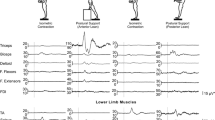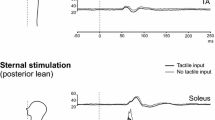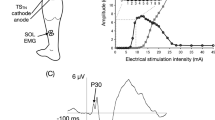Abstract
Sudden limb displacement evokes a complex sequence of compensatory muscle activity. Following the short-latency reflex and preceding voluntary reactions is an epoch termed the medium-latency reflex (MLR) that could reflect spinal processing of group II muscle afferents. One way to test this possibility is oral ingestion of tizanidine, an alpha-2 adrenergic agonist that inhibits the interneurons transmitting group II signals onto spinal motor neurons. We examined whether group II afferents contribute to MLR activity throughout the major muscles that span the elbow and shoulder. MLRs of ankle muscles were also tested during walking on the same day, in the same participants as well as during sitting in a different group of subjects. In contrast to previous reports, the ingestion of tizanidine had minimal impact on MLRs of arm or leg muscles during motor actions. A significant decrease in magnitude was observed for 2/16 contrasts in arm muscles and 0/4 contrasts in leg muscles. This discrepancy with previous studies could indicate that tizanidine’s efficacy is altered by subtle changes in protocol or that group II afferents do not substantially contribute to MLRs.







Similar content being viewed by others
References
Af Klint R, Mazzaro N, Nielsen JB, Sinkjaer T, Grey MJ (2010) Load rather than length sensitive feedback contributes to soleus muscle activity during human treadmill walking. J Neurophysiol 103:2747–2756
Blanchette A, Lambert S, Richards CL, Bouyer LJ (2011) Walking while resisting a perturbation: effects on ankle dorsiflexor activation during swing and potential for rehabilitation. Gait Posture 34:358–363
Bouyer LJ (2011) Chap. 8—challenging the adaptive capacity of rhythmic movement control: from denervation to force field adaptation. Prog Brain Res 188:119–134
Bove M, Nardone A, Schieppati M (2003) Effects of leg muscle tendon vibration on group Ia and group II reflex responses to stance perturbation in humans. J Physiol 550:617–630
Bras H, Jankowska E, Noga B, Skoog B (1990) Comparison of effects of various types of NA and 5-HT agonists on transmission from group II muscle afferents in the cat. Eur J Neurosci 2:1029–1039
Chan CW, Jones GM, Kearney RE, Watt DG (1979) The ‘late’ electromyographic response to limb displacement in man. I. Evidence for supraspinal contribution. Electroencephalogr Clin Neurophysiol 46:173–181
Christensen LO, Petersen N, Andersen JB, Sinkjaer T, Nielsen JB (2000) Evidence for transcortical reflex pathways in the lower limb of man. Prog Neurobiol 62(3):251–272
Christensen LO, Andersen JB, Sinkjaer T, Nielsen J (2001) Transcranial magnetic stimulation and stretch reflexes in the tibialis anterior muscle during human walking. J Physiol 531(Pt 2):545–557
Cody FW, Goodwin CN, Richardson HC (1987) Effects of ischaemia upon reflex electromyographic responses evoked by stretch and vibration in human wrist flexor muscles. J Physiol 391:589–609
Corna S, Grasso M, Nardone A, Schieppati M (1995) Selective depression of medium-latency leg and foot muscle responses to stretch by an alpha 2-agonist in humans. J Physiol 484:803–809
Crago PE, Houk JC, Hasan Z (1976) Regulatory actions of human stretch reflex. J Neurophysiol 39:925–935
Davis RA, Davis L (1981) Decerebrate rigidity in animals. Neurosurgery 9:79–89
Day BL, Riescher H, Struppler A, Rothwell JC, Marsden CD (1991) Changes in the response to magnetic and electrical stimulation of the motor cortex following muscle stretch in man. J Physiol 433:41–57
Desmedt JE (ed) (1978) Cerebral motor control in man: long loop mechanisms. Progress in clinical neurophysiology, vol. 4, Karger, Basel
Diener HC, Bootz F, Dichgans J, Bruzek W (1983) Variability of postural “reflexes” in humans. Exp Brain Res 52:423–428
Doemges F, Rack PM (1992) Task-dependent changes in the response of human wrist joints to mechanical disturbance. J Physiol 447:575–585
Edin BB, Vallbo AB (1990) Dynamic response of human muscle spindle afferents to stretch. J Neurophysiol 63(6):1297–1306
Evarts EV, Fromm C (1981) Transcortical reflexes and servo control of movement. Can J Physiol Pharmacol 59:757–775
Fellows SJ, Domges F, Topper R, Thilmann AF, Noth J (1993) Changes in the short- and long-latency stretch reflex components of the triceps surae muscle during ischaemia in man. J Physiol 472:737–748
Friemert B, Franke S, Gollhofer A, Claes L, Faist M (2010) Group I afferent pathway contributes to functional knee stability. J Neurophysiol 103:616–622
Gielen CC, Ramaekers L, van Zuylen EJ (1988) Long-latency stretch reflexes as co-ordinated functional responses in man. J Physiol 407:275–292
Graham KM, Moore KD, Cabel DW, Gribble PL, Cisek P, Scott SH (2003) Kinematics and kinetics of multijoint reaching in nonhuman primates. J Neurophysiol 89:2667–2677
Grey MJ, Ladouceur M, Andersen JB, Nielsen JB, Sinkjaer T (2001) Group II muscle afferents probably contribute to the medium latency soleus stretch reflex during walking in humans. J Physiol 534:925–933
Hammond PH (1956) The influence of prior instruction to the subject on an apparently involuntary neuro-muscular response. J Physiol 132:17–18
Hayashi R, Becker WJ, White DG, Lee RG (1987) Effects of ischemic nerve block on the early and late components of the stretch reflex in the human forearm. Brain Res 403:341–344
Hendrie A, Lee RG (1978) Selective effects of vibration on human spinal and long-loop reflexes. Brain Res 157:369–375
Kimura T, Haggard P, Gomi H (2006) Transcranial magnetic stimulation over sensorimotor cortex disrupts anticipatory reflex gain modulation for skilled action. J Neurosci 26:9272–9281
Kurtzer IL, Pruszynski JA, Scott SH (2008) Long-latency reflexes of the human arm reflect an internal model of limb dynamics. Curr Biol 18:449–453
Kurtzer I, Pruszynski JA, Scott SH (2010) Long-latency and voluntary responses to an arm displacement can be rapidly attenuated by perturbation offset. J Neurophysiol 103:3195–3204
Lee RG, Tatton WG (1982) Long latency reflexes to imposed displacements of the human wrist: dependence on duration of movement. Exp Brain Res 45:207–216
Lewis GN, Perreault EJ, MacKinnon CD (2005) The influence of perturbation duration and velocity on the long-latency response to stretch in the biceps muscle. Exp Brain Res 163:361–369
Lourenco G, Iglesias C, Cavallari P, Pierrot-Deseilligny E, Marchand-Pauvert V (2006) Mediation of late excitation from human hand muscles via parallel group II spinal and group I transcortical pathways. J Physiol 572:585–603
Mackel R, Brink EE, Nakajima Y (1984) Action of tizanidine on responses of forearm flexors and extensors to torque disturbances. J Neurol Neurosurg Psychiatry 47:1109–1116
Malanga G, Reiter RD, Garay E (2008) Update on tizanidine for muscle spasticity and emerging indications. Expert Opin Pharmacother 9:2209–2215
Marchand-Pauvert V, Nicolas G, Marque P, Iglesias C, Pierrot-Deseilligny E (2005) Increase in group II excitation from ankle muscles to thigh motoneurones during human standing. J Physiol 566:257–271
Marque P, Nicolas G, Simonetta-Moreau M, Pierrot-Deseilligny E, Marchand-Pauvert V (2005) Group II excitations from plantar foot muscles to human leg and thigh motoneurones. Exp Brain Res 161(4):486–501
Marsden CD, Rothwell JC, Day BL (1983) Long-latency automatic responses to muscle stretch in man: origin and function. Adv Neurol 39:509–539
Matthews PB (1970) A reply to criticism of the hypothesis that the group II afferents contribute excitation to the stretch reflex. Acta Physiol Scand 79(3):431–433
Matthews PB (1984) Evidence from the use of vibration that the human long-latency stretch reflex depends upon spindle secondary afferents. J Physiol 348:383–415
Matthews PB (1986) What are the afferents of origin of the human stretch reflex, and is it a purely spinal reaction? Prog Brain Res 64:55–66
Matthews PB (1989a) Analysis of human long-latency reflexes by cooling the peripheral conduction pathway; which afferents are involved? Prog Brain Res 80:103–112 (discussion 57–60)
Matthews PB (1989b) Long-latency stretch reflexes of two intrinsic muscles of the human hand analysed by cooling the arm. J Physiol 419:519–538
Matthews PB, Farmer SF, Ingram DA (1990) On the localization of the stretch reflex of intrinsic hand muscles in a patient with mirror movements. J Physiol 428:561–577
Maupas E, Marque P, Roques CF, Simonetta-Moreau M (2004) Modulation of the transmission in group II heteronymous pathways by tizanidine in spastic hemiplegic patients. J Neurol Neurosurg Psychiatry 75:130–135
Meskers CG, Schouten AC, Rich MM, de Groot JH, Schuurmans J, Arendzen JH (2010) Tizanidine does not affect the linear relation of stretch duration to the long latency M2 response of m. flexor carpi radialis. Exp Brain Res 201:681–688
Mirbagheri MM1, Chen D, Rymer WZ (2010) Quantification of the effects of an alpha-2 adrenergic agonist on reflex properties in spinal cord injury using a system identification technique. J Neuroeng Rehabil 7:29
Nakazawa K, Yamamoto SI, Yano H (1997) Short- and long-latency reflex responses during different motor tasks in elbow flexor muscles. Exp Brain Res 116:20–28
Nardone A, Schieppati M (1998) Medium-latency response to muscle stretch in human lower limb: estimation of conduction velocity of group II fibres and central delay. Neurosci Lett 249(1):29–32
Noel M, Cantin B, Lambert S, Gosselin CM, Bouyer LJ (2008) An electrohydraulic actuated ankle foot orthosis to generate force fields and to test proprioceptive reflexes during human walking. IEEE Trans Neural Syst Rehabil Eng 16:390–399
Noel M, Fortin K, Bouyer LJ (2009) Using an electrohydraulic ankle foot orthosis to study modifications in feedforward control during locomotor adaptation to force fields applied in stance. J Neuroeng Rehabil 6:16
Noga BR, Jankowska E, Skoog B (1995) Depression of transmission from group II muscle afferents by electrical stimulation of the cuneiform nucleus in the cat. Exp Brain Res 105:25–38
Petersen N, Christensen LO, Morita H, Sinkjaer T, Nielsen J (1998) Evidence that a transcortical pathway contributes to stretch reflexes in the tibialis anterior muscle in man. J Physiol 512 (Pt 1):267–276
Pruszynski JA, Kurtzer I, Scott SH (2008) Rapid motor responses are appropriately tuned to the metrics of a visuospatial task. J Neurophysiol 100:224–238
Pruszynski JA, Kurtzer I, Lillicrap TP, Scott SH (2009) Temporal evolution of “automatic gain-scaling. J Neurophysiol 102:992–1003
Pruszynski JA, Kurtzer I, Nashed JY, Omrani M, Brouwer B, Scott SH (2011) Primary motor cortex underlies multi-joint integration for fast feedback control. Nature 478:387–390
Riddell JS, Jankowska E, Eide E (1993) Depolarization of group II muscle afferents by stimuli applied in the locus coeruleus and raphe nuclei of the cat. J Physiol 461:723–741
Riddell JS, Jankowska E, Huber J (1995) Organization of neuronal systems mediating presynaptic inhibition of group II muscle afferents in the cat. J Physiol 483:443–460
Schieppati M, Nardone A (1997) Medium-latency stretch reflexes of foot and leg muscles analysed by cooling the lower limb in standing humans. J Physiol 503:691–698
Schuurmans J, de Vlugt E, Schouten AC, Meskers CG, de Groot JH, van der Helm FC (2009) The monosynaptic Ia afferent pathway can largely explain the stretch duration effect of the long latency M2 response. Exp Brain Res 193:491–500
Scott SH (1999) Apparatus for measuring and perturbing shoulder and elbow joint positions and torques during reaching. J Neurosci Methods 89:119–127
Shemmell J, An JH, Perreault EJ (2009) The differential role of motor cortex in stretch reflex modulation induced by changes in environmental mechanics and verbal instruction. J Neurosci 29:13255–13263
Simonetta-Moreau M, Marque P, Marchand-Pauvert V, Pierrot-Deseilligny E (1999) The pattern of excitation of human lower limb motoneurones by probable group II muscle afferents. J Physiol 517(Pt 1):287–300
Singh K, Scott SH (2003) A motor learning strategy reflects neural circuitry for limb control. Nat Neurosci 6:399–403
Sinkjaer T, Andersen JB, Larsen B (1996) Soleus stretch reflex modulation during gait in humans. J Neurophysiol 76:1112–1120
Skoog B (1996) A comparison of the effects of two antispastic drugs, tizanidine and baclofen, on synaptic transmission from muscle spindle afferents to spinal interneurones in cats. Acta Physiol Scand 156:81–90
Soechting JF, Lacquaniti F (1988) Quantitative evaluation of the electromyographic responses to multidirectional load perturbations of the human arm. J Neurophysiol 59:1296–1313
Toft E, Sinkjaer T, Andreassen S, Larsen K (1991) Mechanical and electromyographic responses to stretch of the human ankle extensors. J Neurophysiol 65(6):1402–1410
Tsuji T, Rothwell JC (2002) Long lasting effects of rTMS and associated peripheral sensory input on MEPs, SEPs and transcortical reflex excitability in humans. J Physiol 540:367–376
Uysal H, Larsson LE, Efendi H, Burke D, Ertekin C (2009) Medium-latency reflex response of soleus elicited by peroneal nerve stimulation. Exp Brain Res 193:275–286
Uysal H, Kizilay F, Inel SE, Ozen H, Pek G (2012) Medium-latency reflex response elicited from the flexor carpi radialis by radial nerve stimulation. Exp Brain Res 217:223–235
Wagstaff AJ, Bryson HM (1997) Tizanidine. A review of its pharmacology, clinical efficacy and tolerability in the management of spasticity associated with cerebral and spinal disorders. Drugs 53:435–452
Wiesendanger M, Miles TS (1982) Ascending pathway of low-threshold muscle afferents to the cerebral cortex and its possible role in motor control. PhysiolRev 62:1234–1270
Acknowledgements
The present research was supported by a grant from the Natural Sciences and Engineering Research Council of Canada and a grant from the Canadian Institute of Health Research (CIHR). SHS is supported by a GlaxoSmithKline-CIHR chair in Neuroscience. We wish to thank Kim Moore, Helen Bretzke, and Justin Peterson for technical and logistic support.
Author information
Authors and Affiliations
Corresponding authors
Additional information
Isaac Kurtzer and Laurent J. Bouyer are co-first authors.
Rights and permissions
About this article
Cite this article
Kurtzer, I., Bouyer, L.J., Bouffard, J. et al. Variable impact of tizanidine on the medium latency reflex of upper and lower limbs. Exp Brain Res 236, 665–677 (2018). https://doi.org/10.1007/s00221-017-5162-6
Received:
Accepted:
Published:
Issue Date:
DOI: https://doi.org/10.1007/s00221-017-5162-6




